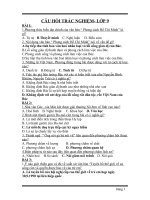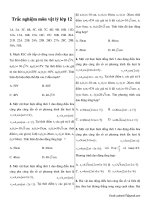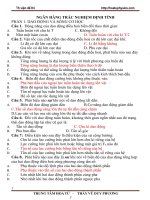TRẮC NGHIỆM TIẾNG ANH CHUYÊN NGÀNH DƯỢC CÓ ĐÁP ÁN
Bạn đang xem bản rút gọn của tài liệu. Xem và tải ngay bản đầy đủ của tài liệu tại đây (67.78 KB, 20 trang )
FINAL TEST
1. The spleen is responsible for removing old ________________from the circulation
a. white blood cells
b. young red blood cells
c. red blood cells
d. b and c
2. The phrase “Increase in white blood cells” is call by the term____________
a. anemia
b. leukemia
c. hematoma
d. thyoma
3. Blood is made up of ____________________________
a. red blood cells ( erythrocytes)
b. white blood cells (leukocytes)
c. platelets and plasma
d. all of the above
4. __________________ fight bacterial infections by producing antibodies
a. leukocytes
b. erythrocytes
c. platelets
d. plasma
5. The word muscle comes from the Latin mus (_______) and cle (little) because muscle
movements resemble a mouse moving under a cover
a. mice
b. mouse
c. rat
d. all of the above
6. The body contains more than ____ muscles which give shape and movement
a. 560
b. 600
c. 640
d. 780
7. The root “chondr” refer to meaning as ______________
a. tendon
b. cartilage
c. Muscle
d. bone
8. The area of increased hardness is call “___________”
a. dermatitis
b. Keratosis
c. subcutaneous
d. transdermal
9. Skin inflammation is call “___________”
a. dermatitis
b. Keratosis
c. subcutaneous
d. transdermal
10. The lymphatic system is the center of the body’s ________system
a. immune
b. blood
c. cardiovascular
d. reproductive
11. The phrase “Removal of the spleen” is call by the term____________
a. splenectomy
b. anatomy
c. anemia
d. thyoma
12. Fingers nails and toe nails are also composed of __________
a. keratin
b. gelatin
c. protein
d. lipoprotein
13. The epidermis ______________ and is constantly discarding dead cells
a. has a lot of nerves
b. has a lot of blood
c. has a lot of lymphatics
d. none of the above
14. The small adrenal glands produce such hormones as aldosterone, _______
a. cortisol
b. androgens
c. estrogens
d. all of the above
15. The GI tract contains the organs that are involved in ______of foods and ______ of
nutriens
a. the digestion , the absortion
b. the digestion , the excretion
c. distingration , the absortion
d. the metabolism , the absortion
16. The alimentary tract refers to the system that goes from ____________
a. the mouth to anus
b. the esophagus to the anus
c. the stomach to the anus
d. the small intestine to the anus
17. The root “ ________” refer to meaning as sugar
a. somat
b. thyr
c. glucose
d. glyc
18. The word “ ________” refer to the meaning of the root “lipid”
a. glyc
b. fat
c. somat
d. thyr
19. The term “___________” refer to the meaning of Increase lipids in the blood
a. endocrine
b. hyperlipidemia
c. hypothyroidism
d. somatic
20. The word “hypoglycemia” is mean
a. low blood sugar
b. High blood sugar
c. low hypertensive
d. high hypertensive
21. The __________system distributes blood throughout the body using blood vessels
a. lymphatic blood
b. cardiovascular
c. endocrine
d. none of the above
22. Chermicals that assit in regulating body functions are called ______
a. antibodies
b. hormones
c. proteins
d. catalists
23. The puitary gland produces multiple hormones and is located at _________
a. the base of the brain
b. heart
c. liver
d. stomach
24. ________ is a term that mean a Loss of memory
a. Dysphasia
b. neuralgia
c. Dementia
d. Meningitis
25. ________ is a term that mean a Difficulty of speaking
a. Dysphasia
b. neuralgia
c. Dementia
d. Meningitis
26. ________: a system of glands that secrete hormones into the bloodstream
a. Endocrine system
b. intergumentary system
c. respiratory system
d. reproductive system
27. The medulla region of the __________produce the catecholamines adrenalin
(epinephrine) and noradrenaline (norepinephrine)
a. puitary glands
b. andrenal glands
c. thymus glands
d. thyroid glands
28. The word “________” is mean too much thyroid activity
a. hypertension
b. hyperthyroidism
c. hyperglycemia
d. hyperlipidemia
29. The word “________” is mean a Disease of the heart muscle tissue
a. atherosclerosis
b. cardiomyopathy
c. atrial fibrillation
d. congestive heart failure
30. The root “ ________” refer to the meaning body
a. somat
b. thyr
c. glucose
d. glyc
31. The root “ ________” refer to the meaning kidney
a. glyc
b. nephr
c. somat
d. thyr
32. The term “ ________” refer to the meaning high blood sugar
a. hypothyroidism
b. hyperglycemia
c. hyperlipidemia
d. endocrine
33. The term “ ________” refer to the meaning high blood pressure
a. atherosclerosis
b. cardiomyopathy
c. hypertension
d. thrombosis
34. The term “ ________” refer to Blood clots in the vascular system
a. atherosclerosis
b. cardiomyopathy
c. hypertension
d. thrombosis
35. In addition, the patient receives information on the _________as well as from an
information sheet supplied with the medication
a. prescription label
b. doctor’s information
c. pharmacist’s information
d. all of the above
36. Rx is an abbreviation of Latin word “_____” which means “___” today it is
commonly associated with the word “ prescription”
a. recipe, give
b. recipe, take
c. prescription, dispense
d. prescription, refill
37. ___________ dispense directly to the patient and the patient is expected to administer
the medication according to the pharmacist’s directions
a. family doctors
b. Community pharmacists
c. hospital clinic pharmacists
d. all of the above
38. The root word “ card” is pertaining to the _______ of body
a. chest
b. breast
c. lung
d. none of the above
39. “_________” is the root word is pertaining to skin, or things related to the skin
a. card
b. derma
c. hepat
d. pneum
40. “hemat” is the root word that refer to _____
a. liver
b. blood
c. lung
d. heart
41. The term “ ________” refer to meaning of a deficiency of thyroid secretion
a. hyperthyroidism
b. hyperglycemia
c. hyperlipidemia
d. none of the above
42. The most complex of the body organ systems is ______
a. the gastrointestinal system
b. the nervous system
c. the cardiovascular system
d. the skeletal system
43. The peripheral nervous system is composed of nerves that branch out from ___
a. the spinal cord
b. the brain
c. the intercostal
d. all of the above
44. The top layer of the skin is referred to as _____layer
a. epidermis
b. dermis
c. cutaneous
d. subcutaneous
45. The prescription : “ Cephalexin 500mg , Sig:
explaination below can be right, but except one:
cap po QID x 10 # 40” , the
a. cap po mean “take one capsule by mouth”
b. QID means “four times a day”
c. x 10 means “for ten days”
d. # 40 means quantity of 40 days
46. “GI” is a abbreviation of the word ________
a. gallbladder intestinal
b. gastrointestinal
c. gastroinflammable
d. none of the above
47. _____aministration is the most frequently used of aministration
a. sublingal
b. bulk
c. Oral
d. rectal
48. The term “tentitis” has meaning as a ________
a. chronic pain in muscles
b. increase in muscle death
c. plactis surgery of muscle tissue
d. inflammation a tendon
49. The ____ layer of tissue is beneath the dermis but is closely interconnected to it
a. sudcutaneous
b. transdermal
c. Keratosis
d. dermatitis
50. _______ is term that means a inflammation of the joint
a. arthritis
b. osteoarthritis
c. Osteocarcinoma
d. rachitis
51. The _____counsels the patient or the patient’s representative when the prescription is
purchased
a. pharmacist
b. doctor
c. optican
d. physican
52. The ______system is the body’s first line of defense, acting as a barrier against disease
and physical hazards
a. muscular
b. skeletal
c. immune
d. integumentary
53. ________ glands are part of the ingumentary system
a. adrenal
b. pituitary
c. thyroid
d. mammary
54. The word muscle comes from the Latin mus (_______) and cle (_____) because
muscle movements resemble a mouse moving under a cover
a. kangaroo, big
b. mouse, little
c. koala, little
d. hamster, tiny
55. The gelatin shell dissolves in the______ and releases the content of the capsules
a. liver
b. stomach
c. intestine
d. pancrease
56. ________ dosage forms are easy to carry, use, and administer by mouth
a. oral
b. intravenous
c. intranasal
d. dermal
57. The dosage form of PO is to be swallowed and that absorption will occur primary from
___________
a. the mouth and the stomach
b. the stomach and the intestine
c. the intestine and the anus
d. all of the above
58. The abbreviation “tid” means as ___________
a. three times a day
b. twice a day
c. take it with direction
d. none of the above
59. The abbreviation “tsp” means as ________(= 5ml)
a. teaspoon
b. tablespoon
c. soupspoon
d. a and c
60. The word “gastritis” means inflammnation of the _______
a. esophagus
b. stomach
c. intestines
d. spleen
61. The “pneumothorax” means area of the chest containing the ____
a. lungs
b. pharynx
c. larynx
d. trache
62. The pancreas is located _______the stomach and also contributes enzymes to the
digestive process
a. front
b. next by
c. behind
d. none of the above
63. Drugs administered in _______dosage forms generally reach the circulatory system
faster than drugs formulated in _____dosage forms
a. solid, solution
b. liquid, solid
c. paste, liquid
d. solid, liquid
64. The ______system is a living one that undergoes dynamic changes throughout life
a. skeletal
b. muscular
c. integumentary
d. respiratory
65. _________ is a term that means a Inflammation a tendon
a. arthritis
b. tenditis
c. rachitis
d. osteoarthitis
66. The “pneumothorax” means area of the chest containing the ____
a. nasal cavities
b. pharynx
c. larynx
d. none of the above
67. The word “neuralgia” is mean________
a. pain in nerve
b. loss of memory
c. inflammation of nerve
d. all of the above
68. The thyroid gland is located just below ______and releases hormones important for
regulating body metabolism.
a. the larynx
b. Stomach
c. Bladder
d. Chest
69. _______phase the blood pressure after the heart has completed a pumping stroke
a. sytolic
b. Diastolic
c. relaxtive
d. b and c
70. The ______system is made up largely of hard osseous tissue
a. integumentary
b. skeletal
c. cardiovascular
d. none of the above
71. The abbreviation “qd” means as _________
a. quickly drink
b. quickly direct
c. quickly dicrease
d. none of the above
72. The abbreviation “__” means as twice a day
a. bid
b. tid
c. tsp
d. none of the above
73. The root “_____” refer to the meaning fat
a. glyc
b. lipid
c. somat
d. thyr
74. Any medical science term will have at least one ____word and then a ____or _____to
complete the meaning
a. suffix, prefix, root
b. prefix, suffix, Root
c. roor, suffix, prefix
d. suffix, root, prefix
75. If a phrase contains the word “ cardiac” it is referring to the ____
a. heart
b. chest
c. breast
d. all of the above
76. “Cyst” is the root word that refer to _________
a. cell
b. muscle
c. tissue
d. bladder
77. “ xero” is a prefix used to describe the things that are___
a. wet
b. dry
c. hard
d. soft
78. Signa is abbreviated to Sig or S meaning __________
a. to write
b. to sign
c. to review
d. to remind
79. The term “tenditis” has meaning as a ________
a. chronic pain in muscle
b. increase in muscle death
c. plactic surgery of muscle tissue
d. Inflammation a tendon
80. The word “xeroderm” means a “______” condition
a. dry skin
b. wet skin
c. infectious skin
d. cancerous skin
81. The puitary gland controls the body’s growth and releases ______into the bloodstream
that control much of the activity of the other glands
a. antibodies
b. hormones
c. proteins
d. catalysts
82. The thymus gland is located beneath ___________
a. the brain
b. the stomach
c. the sternum
d. the kidneys
83. Conductive tissue which is unique to _____ is responsible for ____
a. agonist muscle, flexor movement
b. heart muscle, the heart beat
c. antagonist muscle, contaction of muscles
d. all of the above
84. __________phase the blood pressure as the heart is pumping blood into the
cardiovascular system
a. Systolic
b. diastolic
c. breath
d. flow
85. The blood pressure are recorded by numbers such as : 140/90
a. 140 = conductive
90 = inductive
b. 140 = inductive
90 = conductive
c. 140 = systole
90 = diastole
d. 140 = diastole
90 = systole
86. Most tablets are manufactured for ____use, and many are coated with a sweet glaze
a. oral
b. rectal
c. sublingual
d. buccal
87. The GI tract is located in________, and is surrounded by the pertioneal lining
a. the spinal cord
b. the abdomen
c. the head
d. the inner ear
88. Which route of administration is not an enteral route? That is ____
a. rectal
b. inhalation
c. buccal
d. sublingal
89. The _____is the best know for its production of insulin and glucagon
a. kidney
b. liver
c. pipuitary glands
d. pancrease
90. ______ is a term that pertaining to an Inflammation of the brain
a. Encephalitis
b. neralgia
c. Dementia
d. Meningitis
Read the passage below and answer the question 91-92-93-94:
Jane Smith has hypertension and needs a prescription for Vasotec. She will take 5mg,
twice a day. It comes in 5mg tablets. She will need a three month supply with refill of
a year. Her address is ……
91. The phrase “ She will take 5mg twice a day” that mean _______
a. She will take one tablet x 2 times a day
b. She will take two tablet x 1 times a day
c. twice a day is abbreviated by “tid”
d. none of the above
92. How many 5mg tablets are refilled in the prescription?
a. 30
b. 60
c. 120
d. 180
93. What is “hypertension”? that is a _________
a. combination of the word “hyper” and “ tension”
b. high blood pressure
c. heart disease
d. all of the above
94. What problem has Jane Smith? She has _______
a. high blood cholesterol
b. high blood pressure
c. high blood sugar
d. server depression
95. _______tissue which is unique to heart muscle is responsible for the heart beat
a. connective
b. Conductive
c. muscular
d. nervous
96. ____ dosage forms are to carry, use and administer by applying in skin
a. oral
b. intravenous
c. intranasal
d. dermal
97. A dissolution step would not be necessary for drug absorption from a/an _____
a. capsule
b. intramuscular suspension
c. intravenous solution
d. suppository
98. The suppository dissolves in the ____ and releases it’s contents
a. stomach
b. small instestine
c. large instestine
d. rectum
99. Which route of administrations is an parenteral route? That is ____
a. rectal
b. inhalation
c. bucal
d. sublingual
100. The best known example of a drug given by sublingual administration is ___
a. methylpresnisolon
b. alphachymotrypsin
c. cephalexin
d. phosphalugel
101. The ophthalmic formulation, that will maintain the drug in contact with the eye the
longest, is ___
a. solution
b. suspension
c. gel
d. ointment
102. ___ are formulations in which the drug and other ingredients are machine compressed
under high pressure into a shape
a. capsules
b. tablets
c. bulk powders
d. all of the above
103. Modified release tablets might be called ____
a. extended release
b. prolonged action
c. long acting
d. all of the above









